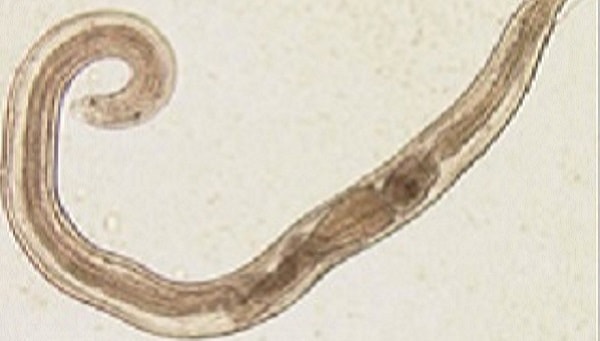Key points
- Pinworm infection is caused by small, thin, white parasitic roundworms.
- Anyone can get pinworm infection, but it primarily affects children, people in long-term care facilities, and household members and caretakers of persons with pinworm infections.
- Medication, handwashing, and good hygiene are the best ways to stop the spread of pinworm.

Overview
Pinworms are a type of parasitic roundworm that can infect your intestines. Parasites are organisms (a living thing) that lives on or inside another organism. Pinworm infection causes itching around the anus (butthole). Anyone can get a pinworm infection, but it usually affects children, people living with or caring for children, and people living in long-term care facilities or institutional settings. Pinworm infection is preventable and treatable.
On average, a single pinworm is about the size of a staple. The scientific name for a pinworm is Enterobius vermicularis and some healthcare providers may use the terms enterobiasis or oxyuriasis to refer to pinworm infection.
Signs and symptoms
Symptoms of pinworm infection are usually mild, and some people have no symptoms. If you do have symptoms, it is typically itching around the anus. Female pinworms lay their eggs at night on the skin around the anus, which can cause the skin to itch. Some infected people have difficulty sleeping or restlessness. Some infected people have reported abdominal pain. Occasionally, pinworms can move to the vaginal area, causing irritation and inflammation. Repeated scratching can make the skin red and puffy and lead to bacterial skin infections—in addition to the pinworm infection.
Risk factors
Pinworm infection occurs worldwide. Pinworms can infect anyone, in any setting, and are the most common worm infection in the United States. Pinworm infection occurs most commonly among
- School-aged and preschool-aged children,
- People in institutional settings, and
- Household members and caretakers of people with pinworm infection.
Pinworm infections often occur in more than one person in a household. It is common to see multiple infections in institutional and childcare settings as pinworms spread easily.
How it spreads
While an infected person sleeps, female pinworms leave the intestine through the anus and deposit their eggs on the surrounding skin. Two to three hours after pinworms lay their eggs, the eggs become capable of infecting other people who accidentally swallow them. The eggs can easily infect another person, especially caretakers or close contacts of infected children or adults:
- If, after they touch an infected area around the anus, or get eggs under their fingernails, they then touch their mouth.
- After pinworm eggs get onto diapers, clothes, bedding, food, or other items, the worms could then make it from the object to someone's mouth. (If not properly washed or cleaned, pinworm eggs can survive 2 – 3 weeks on objects.)
- When pinworm eggs, which are tiny, float through the air and someone breaths them in then swallows them (rare).
Prevention
Washing your hands with soap and warm water is the best way to prevent pinworm infection. This is especially important after
- Using the toilet
- Changing diapers, and
- Touching people who have pinworm or handling items they have used.
Always wash your hands before handling food. Teach children the importance of washing their hands thoroughly and often.
Repeated infections are common. Treat everyone—people infected with pinworms, their caretakers, and members of their household—with the same two-dose treatment. Learn more prevention methods and how to prevent multiple infections and spread.
Diagnosis
If you or someone you know is showing signs of a pinworm infection, speak with your healthcare provider. There are three ways, with your help, your provider can diagnose pinworm infection:
- Look for pinworms around the anus 2 – 3 hours after the who may be infected person goes to sleep.
- Conduct a "tape test" to collect possible pinworm eggs around the anus.
- Look at samples from under the fingernails of the person who may have pinworms.
Learn more about the specific steps to take on the Diagnosis page.
Treatment and recovery
There are medications, both over the counter and prescription, that can treat pinworm infection. If you or someone you care for are experiencing symptoms of pinworm infection, talk with your healthcare provider to be properly diagnosed.
Treat everyone in the same household and caregivers of the person diagnosed with pinworms at the same time. Treatment involves two doses of medication with the second dose given two weeks after the first dose. The medications kill worms but cannot kill eggs. The second dose is important to prevent infection by newly hatched adult worms that were not killed by the first treatment because they were still eggs.
